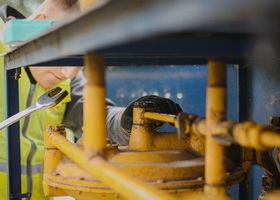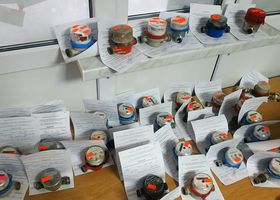Biomethane in Ukraine: prospects, challenges and export breakthrough
Biomethane is gradually becoming not only an important environmental resource, but also an export pillar of the Ukrainian energy industry.

On June 12, 2025, a large-scale conference was held at the Hilton Hotel, which brought together leading Ukrainian and international experts to discuss the future of biomethane. The participants of the event paid attention to the economic advantages of this type of fuel, potential financing models, environmental aspects and sustainable development strategies, and also outlined the challenges and opportunities for the industry in Ukraine.
Ukrainian Energy learned about the potential of Ukrainian biomethane.
Ukraine has a colossal resource for biomethane production - approximately 21.8 billion cubic meters per year. This is four times more than the current level of production in the EU and exceeds the volume of natural gas production in Ukraine in 2024 (19.12 billion cubic meters).
Chairman of the Board of the Bioenergy Association of Ukraine Heorhiy Geletukha emphasizes:
"With an average export price of €0.9 per cubic meter, biomethane can bring about €20 billion per year."
In his opinion, the transition from electricity production to biomethane production is more profitable, but the war significantly hinders the development of this industry.
Producers and first exports
As of mid-2025, three biomethane plants are operating in Ukraine: as part of the agroholdings Vitagro, MHP and Hals Agro. Four more facilities are due to be launched by the end of the year. In total, these enterprises will be able to generate 111 million cubic meters of biomethane annually.
Vitagro has become a pioneer in the field of exports - the first batch of 70 thousand cubic meters was sent to Germany, and in May another delivery of 200 thousand cubic meters was made. The plant's capacity is 3 million cubic meters per year, investments reached €6 million.
In February, MHP exported 27.4 thousand cubic meters, and also made the first commercial supply of biomethane in liquefied form (Bio-LNG). The buyer was Vitol.
Hals Agro also announced export plans, but there is no public information about the first deliveries yet. At the same time, the company reported that it supplies biomethane to the Ukrainian GTS.
However, export remains the only profitable option.
“In Ukraine, biomethane is sold at the price of conventional gas, although it costs about twice as much. This is economically unprofitable,” explains Heorhiy Geletukha.
Vitagro shares this position.
“Without state support, the domestic market does not even cover the cost,” says Volodymyr Ivakhiv, the company’s head of renewable energy projects.
EU: high demand and real money
Unlike Ukraine, the EU has a system of bonuses for environmental friendliness. There, the price of biomethane can reach €900 per 1,000 cubic meters, which makes exports extremely attractive.
The European Union plans to significantly increase biomethane consumption — from the current 5 billion cubic meters. m per year to 35 billion in 2030, and to 150 billion in 2050. But even under the most optimistic scenarios, only 20 billion cubic meters will be achieved by 2030. This creates a significant niche for Ukrainian producers.
Deputy Minister of Energy Mykola Kolisnyk emphasized: “Ukraine can play a key role in providing Europe with “green” gas within the framework of the Fit for 55 and RePowerEU programs.”
In February 2025, the first biomethane pipeline supply to the EU took place - with the support of the state, which developed the necessary regulatory and technical framework.
Kolisnyk also emphasized the need for integration with a single European database, attracting investments, and access to EU financial instruments.
Naftogaz and strategic interest
Naftogaz of Ukraine has also actively participated in the development of the biomethane direction. Its European division, Naftogaz Trading Europe AG, has received certification for biomethane trading.
Head of the Business Development Department of NJSC Denys Kostyuk notes:
“We provide full support — from connection to the GTS to purchase of products under market conditions. This allows producers to avoid complex contracts with European traders.”
A special service center has also been created on the basis of LLC “Gas Distribution Networks of Ukraine” for future producers.
According to Heorhiy Geletukha, four plants are already operating, and three more are at the final stage of transition from biogas production to biomethane. It is expected that they will begin commercial operations in the near future.
A study by Green Deal Ukraine and the Ukrainian Climate Office predicts that by 2030 Ukraine will be able to produce up to 1 billion cubic meters of biomethane annually, and by 2050 — from 6 to 22 billion cubic meters.
Biomethane in Focus
Given Ukraine’s great prospects in this area, a conference was held in Kyiv, bringing together market leaders, government officials, and international partners.
All three thematic sessions of the conference were accompanied by an active discussion, in which both project developers and regulators participated. The team of the Ukrainian Bioenergy Association (UABIO) joined each of the panels, and the final session was moderated by its Chairman of the Board, Heorhiy Geletukha.
During the event, participants examined in detail the economics of biomethane production, ways of financing projects, environmental benefits and strategic importance for the country's energy independence. Considerable attention was paid to the analysis of barriers and ways to overcome them, as well as the role of the state in forming a favorable market.
The conference consisted of three thematic sessions, in which the team of the Bioenergy Association of Ukraine (UABIO) took part. The final session was moderated by the Chairman of the Board of the association, Heorhiy Geletukha.
The participants of the event noted that despite the full-scale war, Ukraine is demonstrating progress in the development of biomethane. The industry is considered an element not only of environmental, but also of geopolitical security, as it allows reducing dependence on fossil fuel imports from the aggressor country. According to estimates, Ukraine's potential in the field of biomethane is over 21 billion cubic meters per year. Four plants with a total annual capacity of 41 million cubic meters are already in operation, and by the end of the year, production is expected to increase to 111 million cubic meters.
“The Verkhovna Rada has good support for biomethane producers. We are promptly resolving existing problems and making appropriate amendments to the legislation on biomethane. If you see any problems, contact us, we will try to resolve everything. I am proud that we are already seeing the development of this area in Ukraine even during the war. Congratulations to everyone! We have created a new subsector of the economy that has great potential. Currently, the number one task is to convert all 80 biogas plants to biomethane,” said Andriy Zhupanin, People’s Deputy of Ukraine.
The first examples of successful biomethane exports to the EU have already been implemented, although Ukrainian companies face a number of difficulties, including additional logistical costs, the lack of simplified access to EU markets, and restrictions that exist in practice even where they do not exist at the legislative level. At the same time, the potential for trade remains, especially in the UK market, despite the high cost of transportation.
The conference expressed the view that biomethane can not only strengthen Ukraine’s energy independence, but also create a new sector of the economy. Some speakers emphasized the need for more active support from the government, including at the level of intergovernmental cooperation with the European Union.
The participants in the discussions also noted that biomethane production should be accessible not only to large agricultural holdings, but also to medium and small players, otherwise the scenario of the biogas industry, where the market was developed mainly by large players, will be repeated. To do this, it is necessary to create a predictable regulatory framework and attract institutional support.
A separate block of the conference was devoted to new technologies, in particular synthetic methane produced using CO₂ and green hydrogen. Ukrainian companies are already implementing such innovative solutions, demonstrating a high technical level comparable to European models.
Overall, the conference showed that biomethane in Ukraine is no longer just a promising technology - it is becoming a real tool for the country's energy transformation, increasing exports and developing domestic production with high added value.
Biomethane and modern Ukrainian realities
One of the main issues was the connection of biomethane plants to Ukrainian gas networks. The Gazmerezhi company already has successful experience with such integration. According to its representatives, step-by-step instructions for connection are available on the website, but the most important step is an official application from a potential manufacturer.
At the same time, the GTS Operator of Ukraine warns: biomethane can be connected to high-pressure systems only if its characteristics are as close as possible to natural gas. This is a technically complex and financially costly process, so experts advise considering first connecting to distribution systems (GDS), where the requirements are simpler.
Another direction is biomethane storage. According to Ukrtransgaz, Ukraine's underground gas storage facilities allow for the accumulation of significant volumes of fuel - the third largest in the world and the first in Europe. As the company's representative Stanislav Ignatiev noted, experts are also studying the possibility of storing CO₂ in depleted deposits - such as Malyhorozhanske and Rudkivske.
After updating Ukrainian legislation, biomethane export became possible. According to CMS Ukraine lawyer Vitaliy Radchenko, it was possible to remove the conflict that effectively equated biomethane with natural gas and did not allow its export. At the same time, he warned that Ukrainian producers will have to adapt to a large number of EU norms and regulations, in particular regarding the sustainability of production, traceability of the origin of raw materials, and reduction of the carbon footprint.
The certification procedure was explained by Bureau Veritas Ukraine. To enter the European markets, a producer needs to undergo an ISCC audit. But the certification applies not only to the plant itself, but also to the entire chain - from raw materials to traders. This means that every participant in the supply chain must meet sustainability requirements.
Strategic zoning helps determine where to build new biomethane plants. The Bioenergy Association of Ukraine (BAU) presented a methodology that takes into account several factors: availability of raw materials, availability of infrastructure, local demand, and risks associated with war. According to analysts, this approach allowed France to become one of the leaders of the biomethane market in Europe.
Special attention was paid to calculating the carbon intensity of biomethane. As explained by BAU expert Volodymyr Kramar, the final carbon footprint depends not only on the raw materials, but also on technologies. It can be reduced, in particular, by eliminating methane emissions during digestate storage and using biogenic CO₂ instead of fossil.
In addition to traditional agro-waste raw materials, Ukrainian researchers propose using cover crops, lignocellulosic residues, and even microalgae.
Thus, according to BAU expert Tetyana Zhelezna, catch crops grown between main crops have the potential to produce over 9 billion m³ of biomethane per year. They do not compete with food crops and help maintain soil fertility.
Other studies show difficulties with straw processing due to its low moisture content and lignin content. At the same time, scientists offer promising solutions using microalgae, which have an ultra-fast growth cycle — only 15 days — and effectively convert CO₂ into biomass.
In the field of transport, biomethane can become an alternative to diesel, especially for the agricultural sector, where fuel consumption is highest. According to BAU analyst Semen Dragnev, replacing diesel fuel with biomethane will simultaneously reduce greenhouse gas emissions and utilize agricultural waste without harming the environment.
So, as we can see from the event, biomethane is gradually becoming not only an important environmental resource, but also an export pillar of the Ukrainian energy sector. And although the domestic market has not yet been formed, thanks to the support of the EU, state regulation and initiatives of private business, Ukraine is already laying the foundations for a "green" energy future.
Open discussions, new research and legislative breakthroughs indicate that the biomethane sector in Ukraine is reaching a new level of development.
Olena Marchenko, specially for "Ukrainian Energy"








